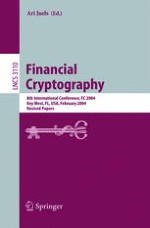2004 | Buch
Financial Cryptography
8th International Conference, FC 2004, Key West, FL, USA, February 9-12, 2004. Revised Papers
herausgegeben von: Ari Juels
Verlag: Springer Berlin Heidelberg
Buchreihe : Lecture Notes in Computer Science
Enthalten in: Professional Book Archive
